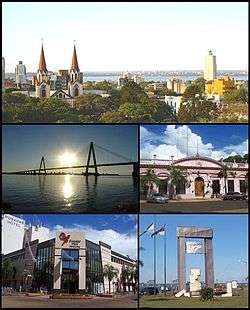Posadas, Misiones
Posadas (Spanish pronunciation: [poˈsaðas]) is the capital city of the Argentine province of Misiones, in its south, at the far north-east of the country on the left bank of the Paraná River, opposite Encarnación, Paraguay. The city has an area of 965 square kilometres (373 sq mi) and a population of 324,756 (2010 census [INDEC]), and the Greater Posadas area has a population of over 359,609 according to a 2017 estimate ("IPEC".).
Posadas | |
|---|---|
 (From top to bottom; from left to right) Panoramic view of the city; San Roque Bridge; Misiones Government House; Posadas Plaza Shopping Centre and the Malvinas Monumet) | |
.svg.png) Flag  Coat of arms | |
 Posadas Location of Posadas in Argentina | |
| Coordinates: 27°22′S 55°54′W | |
| Country | |
| Province | |
| Department | Capital |
| Founded | 1870 |
| Government | |
| • Mayor | Joaquín Losada (Frente Renovador) |
| Elevation | 120 m (390 ft) |
| Population (2010 census & 2017 estimates) | |
| • Urban | 275,028 |
| • Metro | 359,609 |
| Time zone | UTC−3 (ART) |
| CPA base | N3300 |
| Dialing code | +54 376 |
| Website | Official website |
Posadas is the provincial centre of the government, culture and the economy. Furniture, tobacco, food, textiles and construction are its most important industries. Other important economic activities are commerce and services.
Posadas is connected to the Paraguayan city of Encarnación by the San Roque González de Santa Cruz Bridge. The port, once of great economical importance, is used for sport vessels, carrier of passengers and some boats for sand transport. The city is located on National Route 12, some 1,300 kilometres (810 mi) from Buenos Aires. The General José de San Martín Airport (IATA: PSS, ICAO: SARP), at coordinates 27°22′S 55°58′W, is seven kilometres from the city, and features regular flights to Buenos Aires.
History
Father Roque González y de Santa Cruz established a town called Anunciación de Itapúa on March 25, 1615, but ten years later the settlement was moved to the other side of the Paraná River to the present location of Encarnación, Paraguay.
The first settlement was not completely abandoned, and a new San José reduction was settled there in 1628. In 1867, during the Paraguayan War, the Brazilians set up the Trinchera de San José military base there. Following the end of the war, Paraguay renounced all claims to the area, and in 1879, the town was renamed after Gervasio Antonio de Posadas, the Supreme Director of the Argentine Confederation (1814).
On December 22, 1881, the limits of the Misiones Federation were drawn, leaving Posadas within the territory of current Corrientes Province. On July 30, 1884 the National Congress decided to give Posadas to Misiones Province, and name it its capital. The National University of Misiones was established at Posadas in 1973, and in 1990, the city's cultural and economic links to Encarnación were strengthened with the completion of the San Roque González de Santa Cruz Bridge.
Public transportation
The average amount of time people spend commuting with public transit in Posadas, for example to and from work, on a weekday is 57 min. 10% of public transit riders, ride for more than 2 hours every day. The average amount of time people wait at a stop or station for public transit is 16 min, while 26% of riders wait for over 20 minutes on average every day. The average distance people usually ride in a single trip with public transit is 4.3 km, while 2% travel for over 12 km in a single direction.[1]
Origin of the population
The population mainly owns Spanish and indigenous ancestry (of the Avá ethnic group in its majority), generally resulting from the mixture of both parts and with that being the ethnic origin of the settlers who initially made up the city and also of the majority of those who arrived from the 20th century onwards from the rest of the province and especially from Paraguay (whith Paraguayans being the largest foreign group). Among those who migrated from the rest of Misiones there are also descendants of Germans (other people of that descent have migranted from southern Brazil in the first half of the 20th century), Poles and Ukrainians, as well as a small group of Mbyá indigenous people. Another little minorities are Romani, Ashkenazim and descendants of Italians and French, as well also immigrants from Colombia (who arrived since the late 2000s) and Asia (mainly Laotians of the Hmong ethnic group -who arrived in the late 1970s as refugees from the Laotian Civil War-, Japanese -who arrived in the mid-20th century- and Chinese -arrived from the 2000s-). Other immigrants who make up very small numbers and who generally arrived in the late-20th century or 21st century are Bolivians, Haitians (who are mainly university students), Peruvians, Senegalese, South Koreans and Taiwanese.
Climate
| Posadas | ||||||||||||||||||||||||||||||||||||||||||||||||||||||||||||
|---|---|---|---|---|---|---|---|---|---|---|---|---|---|---|---|---|---|---|---|---|---|---|---|---|---|---|---|---|---|---|---|---|---|---|---|---|---|---|---|---|---|---|---|---|---|---|---|---|---|---|---|---|---|---|---|---|---|---|---|---|
| Climate chart (explanation) | ||||||||||||||||||||||||||||||||||||||||||||||||||||||||||||
| ||||||||||||||||||||||||||||||||||||||||||||||||||||||||||||
| ||||||||||||||||||||||||||||||||||||||||||||||||||||||||||||
Posadas has a humid subtropical climate (Köppen Cfa). Summers are hot and humid with lows around 21 °C (69.8 °F), highs around 31.5 °C (88.7 °F), daily mean 26.0 °C (78.8 °F), and frequent thunderstorms. Winters are warm with lows around 12 °C (53.6 °F) and highs around 22.5 °C (72.5 °F), daily mean 17 °C (62.6 °F) . The highest temperature ever recorded was 42.1 °C (107.8 °F) and the coldest was −2.8 °C (27.0 °F).[2]
| Climate data for Posadas Airport (1981–2010, extremes 1961–present) | |||||||||||||
|---|---|---|---|---|---|---|---|---|---|---|---|---|---|
| Month | Jan | Feb | Mar | Apr | May | Jun | Jul | Aug | Sep | Oct | Nov | Dec | Year |
| Record high °C (°F) | 41.2 (106.2) |
39.8 (103.6) |
39.5 (103.1) |
36.2 (97.2) |
34.0 (93.2) |
31.0 (87.8) |
33.0 (91.4) |
38.2 (100.8) |
37.2 (99.0) |
38.3 (100.9) |
41.7 (107.1) |
42.1 (107.8) |
42.1 (107.8) |
| Average high °C (°F) | 33.0 (91.4) |
32.1 (89.8) |
31.2 (88.2) |
27.6 (81.7) |
23.9 (75.0) |
21.9 (71.4) |
21.9 (71.4) |
24.2 (75.6) |
25.1 (77.2) |
28.3 (82.9) |
30.3 (86.5) |
32.4 (90.3) |
27.7 (81.9) |
| Daily mean °C (°F) | 27.0 (80.6) |
26.2 (79.2) |
25.1 (77.2) |
21.9 (71.4) |
18.3 (64.9) |
16.5 (61.7) |
16.1 (61.0) |
17.9 (64.2) |
19.2 (66.6) |
22.3 (72.1) |
24.2 (75.6) |
26.3 (79.3) |
21.8 (71.2) |
| Average low °C (°F) | 21.8 (71.2) |
21.3 (70.3) |
20.2 (68.4) |
17.4 (63.3) |
14.0 (57.2) |
12.3 (54.1) |
11.6 (52.9) |
13.1 (55.6) |
14.3 (57.7) |
17.1 (62.8) |
18.6 (65.5) |
20.7 (69.3) |
16.9 (62.4) |
| Record low °C (°F) | 10.5 (50.9) |
10.3 (50.5) |
5.7 (42.3) |
4.3 (39.7) |
0.6 (33.1) |
−1.5 (29.3) |
−2.8 (27.0) |
−1.8 (28.8) |
1.3 (34.3) |
4.8 (40.6) |
6.9 (44.4) |
9.6 (49.3) |
−2.8 (27.0) |
| Average precipitation mm (inches) | 167.2 (6.58) |
154.9 (6.10) |
144.1 (5.67) |
193.8 (7.63) |
138.2 (5.44) |
139.8 (5.50) |
103.3 (4.07) |
93.9 (3.70) |
145.1 (5.71) |
226.0 (8.90) |
181.0 (7.13) |
179.9 (7.08) |
1,867.2 (73.51) |
| Average precipitation days (≥ 0.1 mm) | 10.3 | 9.6 | 9.0 | 10.2 | 8.3 | 9.4 | 9.0 | 8.3 | 10.9 | 11.3 | 9.5 | 9.4 | 115.2 |
| Average relative humidity (%) | 68.5 | 72.1 | 73.0 | 76.4 | 77.4 | 78.8 | 74.7 | 70.3 | 69.8 | 69.8 | 66.9 | 65.8 | 72.0 |
| Mean monthly sunshine hours | 248.0 | 214.7 | 170.5 | 195.0 | 186.0 | 144.0 | 158.1 | 161.2 | 111.0 | 201.5 | 219.0 | 232.5 | 2,241.5 |
| Percent possible sunshine | 59 | 58 | 45 | 57 | 55 | 46 | 48 | 46 | 31 | 50 | 54 | 54 | 50 |
| Source 1: Servicio Meteorológico Nacional[3][4] | |||||||||||||
| Source 2: UNLP (sun only)[5] | |||||||||||||
Notable people
- José Acasuso, tennis player
- Alberto Mancini, tennis player
- Mariano Messera, soccer player
- German Cano, soccer player
- Daniel Vancsik, golf player
- Danny Veron, dj producer musician
References
- "Posadas Public Transportation Statistics". Global Public Transit Index by Moovit. Retrieved June 19, 2017.

- "Datos Estadísticos (Período 1981-1990)" (in Spanish). National Meteorological Service of Argentina. Retrieved August 23, 2012.
- "Estadísticas Climatológicas Normales - período 1981-2010" (in Spanish). Servicio Meteorológico Nacional. Retrieved January 20, 2018.
- "Clima en la Argentina: Guia Climática por Posadas Aero". Caracterización: Estadísticas de largo plazo (in Spanish). Servicio Meteorológico Nacional. Archived from the original on 4 September 2017. Retrieved 4 October 2017.
- "Datos bioclimáticos de 173 localidades argentinas". Atlas Bioclimáticos (in Spanish). Universidad Nacional de La Plata. Retrieved April 8, 2014.
- "Posadas y sus hermanas" (in Spanish). Primera Edición. Archived from the original on 2015-04-02. Retrieved 2015-03-28.
External links
| Wikivoyage has a travel guide for Posadas. |
- (in Spanish) Municipality of Posadas - Official website.
- (in Spanish) Municipal information: Municipal Affairs Federal Institute (IFAM), Municipal Affairs Secretariat, Ministry of Interior, Argentina. (in Spanish)
- (in Spanish) Universidad Nacional de Misiones
- Posadas Information